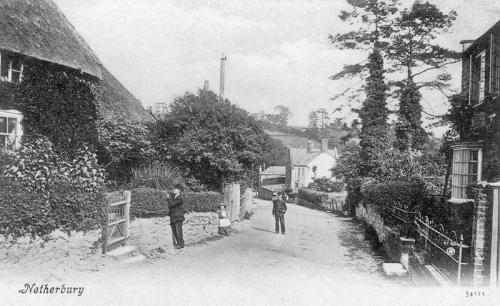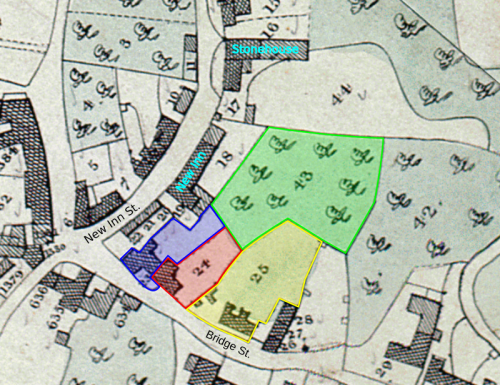This property consists of two houses at the top of Bridge Street currently called Myrtle and Pear Tree Cottages along with an orchard behind them. It would appear the two houses have always been owned as one property although frequently occupied by two different households. A number of businesses and shops have operated from there as well including tallow chandlers, a cooper, a butcher, builders and stone masons. All of which makes it hard to be certain who the occupiers were at any given time.
The earliest recorded owners are from three large and old Netherbury families - Denziloe, Hearn and Cox. They are listed in John Webb's copyholdType of feudal land tenure
with duties and obligations
to the Lord of the Manor Admission document of 1838 which describes the property as "formerly in the possession of Richard Denziloe and John Hearn or one of them since in the possession of John Cox the elder"
Tracing the name Denziloe through the parish records is complicated because it is also recorded as Denselo, Denselow, Densiloe, Densilow, Denslewe, Denslo, Densloe, Denslow, Denslowe & Denzilow.
A Richard Densloe was baptised in 1708 and a Richard Denslow was buried in 1757, both taking place at St Mary's church, but there's no way of being sure that this was the Richard Denziloe who was in possession of the property (or even that they were the same person).
A John Cox, carpenter, married a Sarah Denselow in 1751 but it hasn't been possible to trace her parents. If she was a relative of Richard Denziloe that could explain how John Cox came into possession of the property or he may have simply purchased it. We know that John and Sarah were the parents of Hannah Cox, who was baptised at St Mary's in 1753. John Webb's copyholdType of feudal land tenure
with duties and obligations
to the Lord of the Manor Admission document goes on to list the next owner as "Robert Old and Hannah his wife Daughter of the said John Cox".
John Cox died in August 1782 and his Will details several properties which he left to his daughter, Hannah Old, but unfortunately none of them are Myrtle or Pear Tree Cottages. There's enough detail in the records by then to be confident that we have the right people, so it must be assumed that Robert and Hannah Old had already taken possession of the property before John Cox made his Will some six months before he died. Robert and Hannah had sixteen children baptised at St Mary’s between 1772-1803 so it’s easy to see why they might have needed the space, although it’s probable at least seven of them didn’t survive beyond childhood as their names were reused in later baptisms.
Webbs & Stoodleys
The start of the nineteenth century saw the property move from one established Netherbury family, the Coxs, to another, the Webbs along a branch of that family which was intertwined with Stoodleys by marriage. Both the Webb and Stoodley families were engaged in the tallow business. Tallow is made by rendering down animal fats, usually beef or lamb, by boiling it for several hours and it was then used in the manufacture of candles and soap.
The next name listed in John Webb's Admission document is his father, Thomas Webb, although we have no information about how he obtained the property from Robert and Hannah Old. Thomas married Jenny Stoodley in 1784 who was described as a spinster and he was outlived by Robert Old so it’s probable that the house was purchased rather than inherited.
Thomas Webb nominated his son John as the next copyholdType of feudal land tenure
with duties and obligations
to the Lord of the Manor tenant in a document dated 6th May, 1823 so we know he’d acquired the property some time before that. He died a couple of years later and John, described as a chandler, was granted admission in July 1838.
John, still a bachelor, died in 1860 and the property passed to his brother, another Thomas. It's possible that the transfer of the property unearthed some ambiguity about the exact boundary between the orchard at the north-eastern end of the property and the Grammar School next-door (now Stonehouse) because amongst some old papers linked to Stonehouse there is an "Acknowledgement as to Boundary" dated 25th October, 1861 that says:
Mr Thomas Webb having allowed the boundary wall between his property, and the property of the Grammar School to be built on his side of the ditch, and also having permitted the eaves to project over the said wall. We the churchwardens, and the Master of the said Grammar School agree to pay one penny per year to the said Mr Thomas Webb, when demanded, as an acknowledgement.
The projecting eaves must have been on a building that is no longer there. It doesn't feature on the 1835 Tithe map but can be seen on the 1st Edition OS map of 1889.
The same year as that acknowledgement of the boundary was drawn up Thomas' son, yet another Thomas and an only child, died. Two years later his wife Elizabeth also died and after a further two years Thomas died himself. The property then passed on to his nephew, John Stoodley a Tallow Chandler based in Chard, who was the son of Thomas’ now deceased sister Jane and her husband, another John, described as a “Soap Bolier” which is just another term for a tallow chandler.
An auction was announced in Bridport News at the White Hart in Beaminster on 25th October, 1866 offering:
Lot 1. All that MessuageHouse or dwelling,
inc. outbuildings &
orchard, courtyard
or gardensHouse or dwelling,
inc. outbuildings &
orchard, courtyard
or gardens or Dwelling-house, shop, and premises, pleasantly situate at Netherbury Cross, in the centre of the village of Netherbury, with the gardens and orchard adjoining thereto, containing by estimation 3 roods (more or less), late the residence of Mr Thomas Webb, deceased.
The premises are well adapted for business purposes, and the trade of a tallow chandler having been carried on successfully therein for many years renders them valuable to persons looking out for a business.
Below the announcement was the following:
Immediately after the above Sale will be offered the utensils and machinery of a Tallow Chandler now in and about Lot 1, calculated for making 300 doz. dips per week.
The chain of ownership was complicated and, when he came to sell the property, John Stoodley needed the support of a Declaration prepared by a Commissioner of Oaths in Beaminster laying out the "heirship of Mr John Stoodley to Mr Thomas Webb deceased". This was sworn by Edward Tolley two days after Christmas in 1866 and it confirmed that the property was Stoodley's to sell when the day before he’d signed a copyholdType of feudal land tenure
with duties and obligations
to the Lord of the Manor surrender making the property over to William Thomas Studley, a Cooper from South Perrot, for £300.
The two spellings of the name, Stoodley or Studley, appear to be employed very flexibly and both are used in official documents describing William Thomas. However it hasn't been possible to find any familial link between the two men.
That copyholdType of feudal land tenure
with duties and obligations
to the Lord of the Manor surrender document included a mistake which was then faithfully copied into at least eleven legal documents relating to the property over the next four decades. The error described the three plots that made up the property as being "numbered in the Tithe Commutation Map and Apportionment of the said parish 23, 24 & 25". We know this is incorrect because it also recorded that the plots "contain three roods and seven perches". Referring to the Tithe Apportionment we can see those three plots total just two roods and two perches, however plots 23, 24 & 43 are the right size. The mistake probably happened because, in 1839 when the Tithe Apportionment was drawn up, plot 25 was owned by a Thomas Studley. Whereas plot 43, like plots 23 & 24 was at that time owned by John Cox. Plot 25 is now Dormouse Cottage, Greenwood and Wren Cottage and their gardens. Plot 43 was an orchard that ran behind the New Inn between what are now Pear Tree & Myrtle Cottages and the garden of Stonehouse.
Three months after he bought the property Studley married Mary Ann Walker from Bridport. Five years later, in 1872, a report in the Bridport News said a privy at the house had resulted in the fabulously named Inspector of Nuisances at Netherbury bringing a charge against him. In 1873, he used the house as security for a £60 mortgage from the Equitable Benefit Building Society. He repeats this for the next two years with a further £60 charge against the house each year making £180 in total. It is assumed he didn't keep up the payments on the mortgage because John Frederick Norman and George Gillett, both Trustees of the Equitable Benefit Building Society, took possession of the house at the end of November 1876. The 1881 census lists William, Mary Ann and their six children as living in Salway Ash with his occupation now listed as Innkeeper.
A couple of months after taking possession Norman & Gilbert surrendered the property to John Downe Legg, a Butcher from Netherbury, for £200. That same year he took out a £300 loan from Mrs Sarah French Read of Beaminster, using the house as security. The loan agreement said he had to pay 5% interest per annum or Mrs French could take possession of the property and sell it to recover whatever she was owed, which is what happened 13 years later in 1892.
An announcement appeared in the Western Gazette of Friday 10 June 1892:
TO BUTCHERS IN PARTICULAR AND OTHERS IN SEARCH OF DESIRABLE BUSINESS PREMISES.
MR. SAMUEL COX will OFFER for SALE by PUBLIC AUCTION (subject to Conditions of Sale), at The New Inn, Netherbury, Tuesday, the 14th day of JUNE, 1892 at Four p.m. precisely, all that convenient DWELLING-HOUSE, BUTCHER'S SHOP, SLAUGHTER-HOUSE, OUT-BUILDINGS, GARDEN, and productive ORCHARD, situate in the centre of the Village of Netherbury, containing together about 3r. 7p., now in the respective occupations (excepting the Butcher’s Shop, which is unoccupied) of Miss HANSFORD and Mr. Charles Chard.
Possession of the Property, excepting the Orchard, may be had by arrangement at Midsummer next, and the Orchard at Lady-day, 1893.
The Property is of CopyholdType of feudal land tenure
with duties and obligations
to the Lord of the ManorType of feudal land tenure
with duties and obligations
to the Lord of the Manor tenure, parcel of the Manor of Slape.
Applications to view the Orchard to be made to Mr. Charles Chard at the Star Inn; and the Dwelling-house and other Premisses to Miss HANSFORD, the day prior to the Sale.
Contrary to what was said in the announcement, the day before the sale was completed in November of 1892 the property was "enfranchised" by the Manor of Slape meaning it became freehold rather than copyholdType of feudal land tenure
with duties and obligations
to the Lord of the Manor. The deed of enfranchisement describes Legg as "now of No.3 Station Road Lymington in the County of Hampshire".
Gale & Spracklings
The property was bought for £240 by James Gale from Southampton who, having built up a successful publishing business from nothing, was in the process of retiring at the age of 53. He and his partner were being bought out by a limited company for £30,000 each. Both men were going to be shareholders, and directors on the board of the new limited company and Gale would have continued to benefit from any dividends issued to the shareholders.
Gale had married Jane Sprackling and her brother, Thomas, lived in Netherbury. The 1871 census records Thomas and his young family at the Crook Inn where he was the Innkeeper and a Stone Mason. The 1881 census shows they’d moved to Bridge Street but at that time John Legg was still in residence at Myrtle Cottage.
In 1873 Thomas and his wife Catherine had named their new son James Gale Sprackling so it’s probably reasonable to infer that they were on good terms with Thomas’ sister and her husband. James and Jane Gale didn’t have any children of their own and could afford to be generous to their less wealthy relatives.
James Gale continued to live in Southampton and then, seven years after he’d bought it in 1899, he gave his property in Netherbury to his wife’s niece, Jane Amelia Sprackling. She’d been baptised in Netherbury 31 years earlier but had moved to Southampton and was living about a 1km (½ mile) walk from her aunt and uncle.
A couple of years before this amazing act of generosity Jane had registered the birth of a son, Thomas James Sprackling, in Southampton. It has not been possible to find a record of who the father was and she was not married.
The Deed of Gift that made the property over to her said “for and in the consideration of the esteem and regard which I have for Jane Amelia Sprackling”.
There are a couple of other notable details about the Deed of Gift. It’s the first time the property is named as Myrtle Cottage and it was witnessed by William Gregory, a Clerk.
When James Gale died, aged 62, in 1901 his Will, which had been drawn up earlier that year, essentially left everything to his Wife Jane with no other bequests. One of the two witnesses to the signing of the Will was William Gregory.
In the second quarter of 1902 Jane A Sprackling, aged 34, and William James Gregory, aged 23, were married and the 1911 census lists them as living in Southampton with a fifteen year old Thomas Sprackling who is recorded as William’s step-son.
The bare facts as recorded in various censuses, registers and documents can never capture the nature of the relationships between people and the details of how Jane Amelia Sprackling became the owner of Myrtle Cottage will probably never be known now.
In 1910 she sold Myrtle Cottage and its orchard, etc. to her brother, James Gale Sprackling, for £220 with an indenture that acknowledges that it had “for many years past” been in his occupation. The conveyance for this sale is the first to list the correct Tithe Apportionment plot numbers, dropping plot 25 and including plot 43.
It’s possible that owning the property gave James the confidence to move into farming. The 1901 census lists him as the head of a household at The Cross with the occupation “Builder & Contractor House". The 1911 census lists him and his family as living down the hill at “Highfield, Netherbury” and his occupation is “Builder and Contractor Farmer”. By 1916 the local Jury List shows he’d started farming at Northfield Farm, Beaminster.
James remained the owner until 1927 although there was an attempt to sell up in 1920 when the following announcement appeared in the Western Gazette on 6th August.
IN PRETTY NETHERBURY,
One and Half Miles from Beaminster.
MYRTLE COTTAGE,
An OLD-TIME ROOMY HOUSE, containing 2 Reception-rooms, 5 Bedrooms, and Ample Offices. STABLING and other Useful OUTBUILDINGS, Good GARDEN, and ORCHARD of Choice Apple Trees, which MESSRS. HENRY DUKE and SON are favoured with instructions to SELL by AUCTION, at the White Hart Hotel, Beaminster, on Thursday, September 9th. at. 3.15 p.m.
Further particulars of MESSRS. TROTMAN, Solicitors, Beaminster; or of the Auctioneers. Dorchester.
It’s assumed there wasn’t a high enough bid to secure the sale.
William Way was occupying one of the houses at that time and In 1916 The Western Gazette of 16th June revealed that, amongst many others, “Wm. Way (37), married, Myrtle Cottage, Netherbury, chauffeur, gas plant and water attendant” had applied to the Beaminster Rural Tribunal to be exempted from conscription into the Army. His application was refused. The 1920 edition of Kelly’s Directory carries a listing in the Netherbury, Commercial, section for “Way William, motor car proprietor Myrtle cottage”.
The property eventually left the Sprackling family when it was sold to Thomas James Lewis, a farm worker or labourer, of Netherbury at the end of September 1927. The conveyance described it as “two Dwellinghouses” for the first time and went on to say “now in the respective occupations of Susan Gale and Leonard Symes and Alex Sprackling” without any hint of who was living where. Lewis paid £375 and took out a £75 mortgage on it at 5% interest per annum from Elizabeth Banger Russell of Beaminster. A note appended to the mortgage document states that it was paid off on 2nd April 1943.
The 1939 England and Wales Register compiled at the beginning of World War II shows Thomas Lewis living in Myrtle Cottage with his father, John, as well as his sister Frances and her husband Archibald Pye.
In 1946 Lewis sold the property for £800 to Dame Eilean Flora North, Wife of Admiral Sir Dudley North K.C.V.O., his neighbours living in Stonehouse but both Lewis and Archibald Pye continued living there until their respective deaths in 1951 & 1959.
In 1955, shortly before the Norths moved from Stonehouse to Parnham Lodge, Lady North sold the two dwellinghouses, outbuildings and gardens but not the “Plot 43” orchard to William Hatton Richardson for £1700.
The “Plot 43” orchard had now become part of the Stonehouse property which was bought by John Blair. However, in 1956, Blair sold the southern half of the orchard to Richardson for £99 reuniting it with Myrtle Cottage once again.



